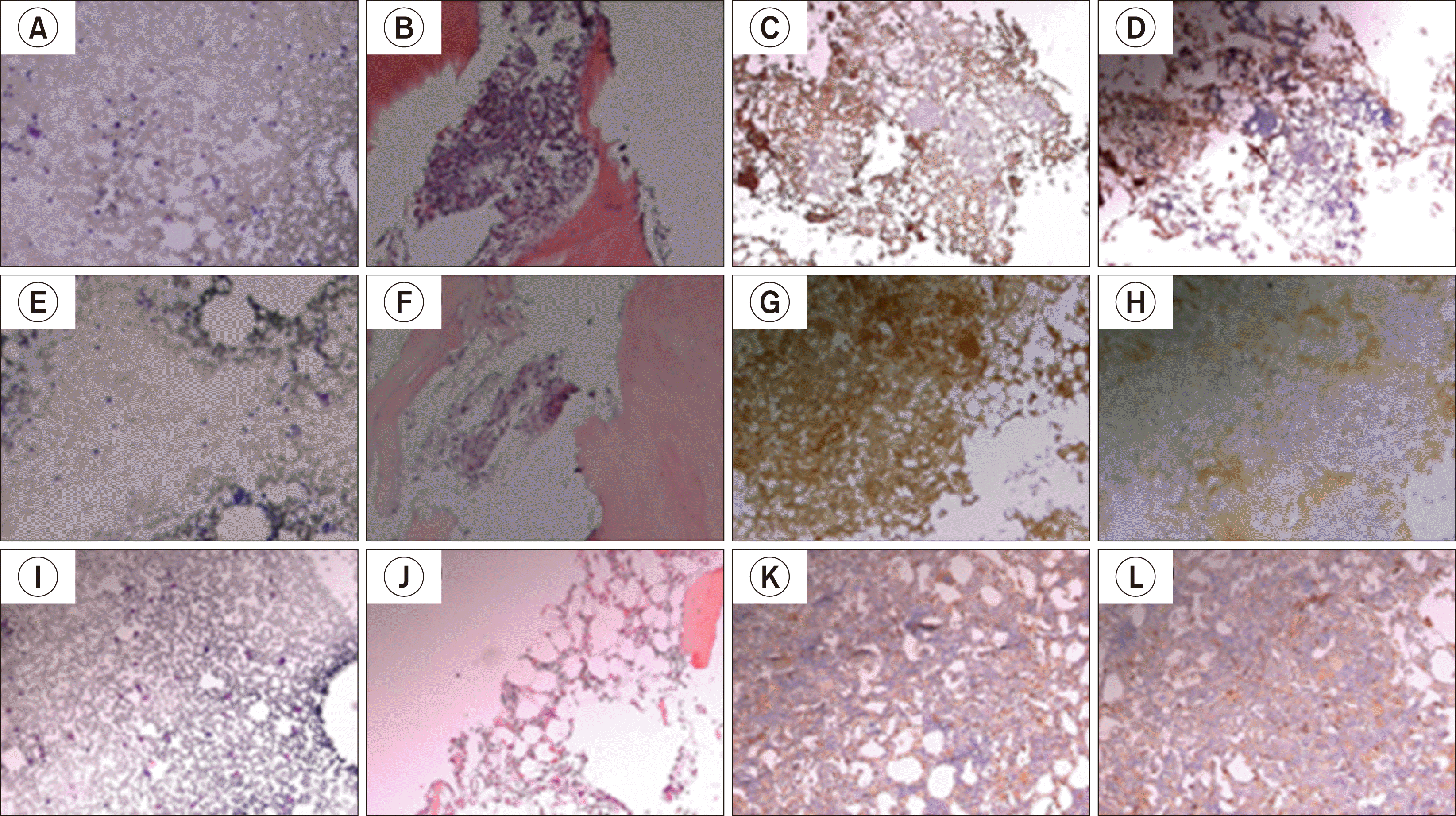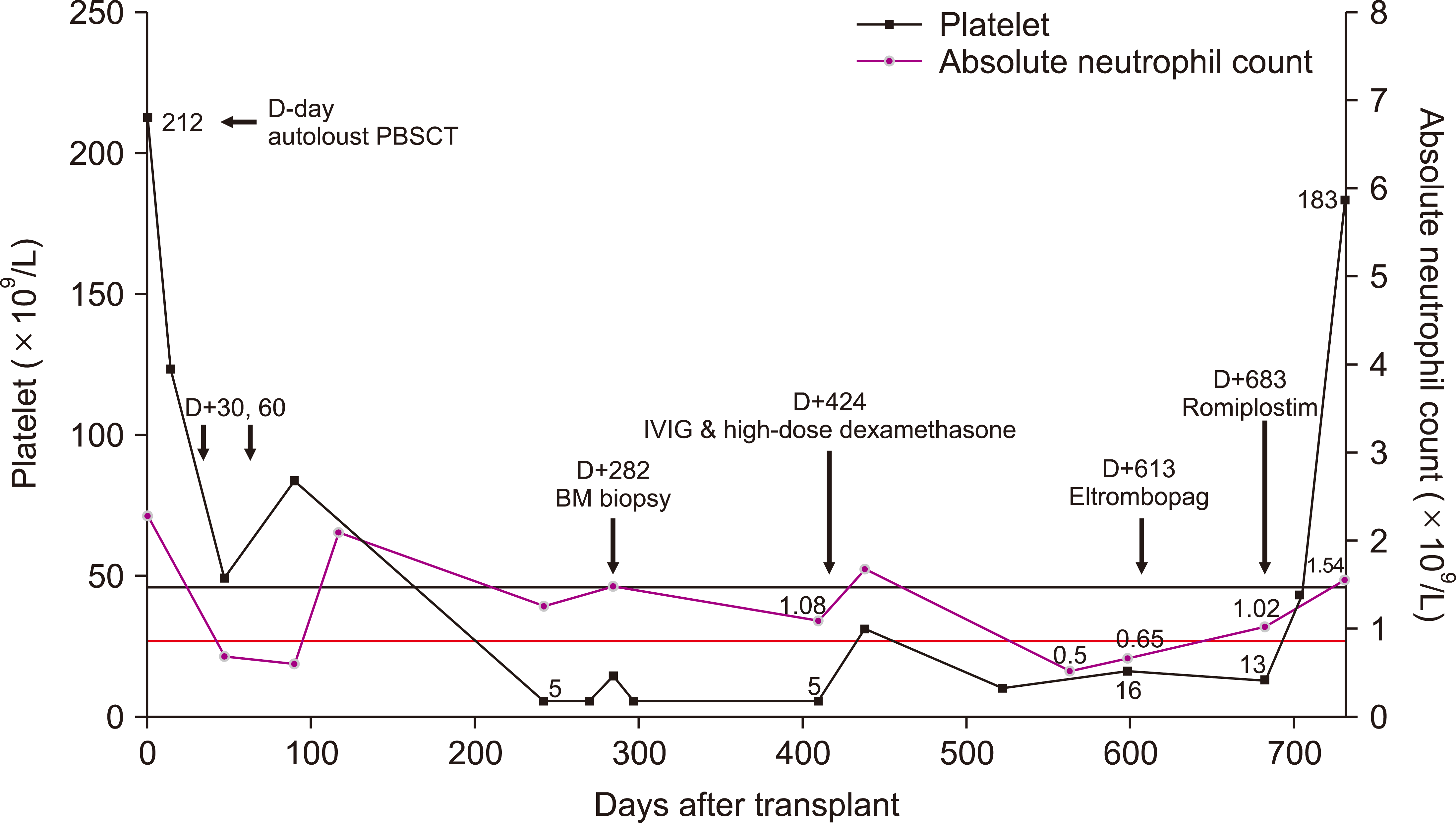This article has been
cited by other articles in ScienceCentral.
TO THE EDITOR: Despite advances in treatment options, including the use of novel agents, such as proteasome inhibitors, immunomodulatory drugs, and monoclonal antibodies, autologous hematopoietic stem cell transplantation (auto-HSCT) remains the cornerstone of treatment of multiple myeloma (MM) [
1]. Following marrow suppression by high-dose chemotherapy as a prelude to auto-HSCT, most patients achieve hematopoietic recovery after autologous stem cell infusion. However, some patients unexpectedly develop poor graft function (PGF). Although there is no universally accepted definition of PGF after auto-HSCT, the European Society for Blood and Marrow Transplantation (EBMT) guidelines suggest defining PGF as two or three cytopenia lasting for at least 2 weeks, 28 days after hematopoietic stem cell transplantation [
2]. In a recent prospective study, PGF was defined as sustained cytopenia, defined as platelet count ≤50,000/µL, and/or hemoglobin ≤8 g/dL, and/or absolute neutrophil count (ANC) ≤1,000/µL [
3].
PGF broadly encompasses several rare disease conditions that are characterized by continued requirements for blood transfusions or an increased risk of infection due to neutropenia, such as post-transplantation immune thrombocytopenia purpura (ITP) or bone marrow aplasia [
4,
5]. Therefore, persistent PGF can negatively impact the quality of life after auto-HSCT. Moreover, it may limit subsequent treatments, such as maintenance or consolidation therapies, and adversely affect disease control. Despite these potential consequences, no systematic approach for diagnosing and managing PGF is known currently.
Thrombopoietin (TPO) receptor agonists (TPO-RAs) enhance the production of hematopoietic stem cells and megakaryocytes by stimulating the TPO receptor, also known as myeloproliferative leukemia protein. Two TPO-RAs, eltrombopag and romiplostim, have been approved by the Food and Drug Administration to treat cytopenia in conditions, such as ITP and aplastic anemia [
6,
7]. Owing to their mechanism of action of stimulating hematopoietic stem cell production, TPO-RAs are currently being explored for the treatment of PGF following auto-HSCT [
5]. However, the existing reports have primarily provided descriptive information, often involving small cohorts. Moreover, studies of post-transplantation PGF have predominantly focused on allogeneic hematopoietic stem cell transplantation.
In this report, we present the case of a patient with MM who successfully recovered from PGF following auto-HSCT by treating with romiplostim. This recovery was achieved even after the initial TPO-RA (eltrombopag) was ineffective. This study was approved by the Institutional Review Board of the Catholic University of Korea (KC22 RISI0540) and was conducted in accordance with the Declaration of Helsinki.
Go to :

CASE
A 62-year-old woman was diagnosed with transplant- eligible MM. The patient underwent a predetermined therapeutic approach, which included six cycles of induction chemotherapy followed by auto-HSCT. The induction chemotherapy regimen consisted of bortezomib, thalidomide, and dexamethasone. She achieved complete response at 15 weeks after initiation of the therapeutic approach. Bone marrow biopsy before auto-HSCT revealed stringent CR (
Fig. 1D). To prepare auto-HSCT, stem cells were mobilized using 10 μg/kg/d of G-CSF for 5 days and of 375 mg/m
2 of etoposide for 1 d. For pretreatment with auto-HSCT, the patient received 3.2 mg/kg/d busulfan for 3 days and 200 mg/m
2/d thiotepa for 2 days [
8]. Subsequently, CD34+ cells at a dose of 4.02×10
6/kg were infused for auto-HSCT. No post auto-HSCT maintenance or consolidation treatments were administered. The patient remained free of clinically significant adverse events for 9 months after auto-HSCT.
 | Fig. 1Images of bone marrow at different time points: before autologous stem cell transplantation (ASCT, upper row: A–D); at 282 days after ASCT, when the patient was diagnosed with poor graft function (middle row: E–H); and at 138 weeks after initiation of romiplostim, demonstrating stringent complete response of multiple myeloma with no evidence of fibrosis or dyspoiesis (lower row: I–L). The first column (A, E, and I) presents bone marrow aspiration, magnified ×100; the second column (B, F, and J) illustrates bone marrow biopsy, magnified ×100; the third column (C, G, and K) shows kappa staining, magnified as ×40 to ×100; the fourth column (D, H, and L) shows lambda staining magnified ×40 to ×100. 
|
At 285 days post-auto-HSCT, the patient’s platelet count unexpectedly dropped to 5×10
9/L, while hemoglobin concentration remained at 11.4 g/dL, and the absolute neutrophil count (ANC) was 1.08×10
9/L, which was within a clinically nonsignificant range (
Fig. 2). We were unable to identify any potential causes of thrombocytopenia, such as graft failure, MM progression, secondary myeloid neoplasm, infection, or toxic drug effects. The diagnosis that we arrived at was post-auto-HSCT PGF, supported by a bone marrow study that revealed 15% cellularity without cytogenetic abnormalities, malignant cancer cells, fibrosis, or dysplastic changes (
Fig. 1G). Considering the prominence of thrombocytopenia within the spectrum of PGF, we initiated treatment with oral dexamethasone (40 mg/d for 4 d) and intravenous immunoglobulin (1 g/kg/d for 2 d) following therapeutic indications for ITP [
9]. Regrettably, these interventions resulted in further neutropenia (0.65×10
9/L), and no platelet recovery (22×10
9/L) was observed 189 days after the initiation of high-dose dexamethasone and intravenous immunoglobulin. Consequently, we revised the diagnosis to post-HSCT PGF rather than ITP, and initiated eltrombopag at a dose of 25 mg/d. However, even with escalated doses of up to 75 mg/day, the platelet count did not recover beyond 22×10
9/L. Subsequently, the patient expressed a preference for romiplostim instead of increasing the off-label eltrombopag dose (eltrombopag, indicated for ITP, is approved for use in South Korea at a maximum dose of 50 mg).
 | Fig. 2Dynamics of platelet count (unit, ×109/L) and absolute neutrophil count (unit, ×109/L) following aut-ologous hematopoietic stem cell transplant and the response to romiplostim. 
|
Given the failure of eltrombopag and uncontrolled PGF with ANC 1.02×10
9/L and a platelet count of 13×10
9/L, we switched from the eltrombopag to romiplostim, initiating romiplostim at a dose of 1 µg/kg per week. Six weeks after initiation, despite using a low dose of romiplostim (1 µg/kg) without dose escalation, PGF was completely resolved, with an ANC of 1.54×10
9/L, a platelet count of 183×10
9/L, and hemoglobin concentration of 12.5 g/dL (
Fig. 2). At 138 weeks after the initiation of romiplostim treatment, restored blood counts were adequately maintained. The bone marrow study showed no minimal residual disease based on 8-color flowcytometry nor other dyspoietic findings, as observed in the morphology and cytogenetic analyses (
Fig. 1H–K).
Go to :

DISCUSSION
Understanding PGF has been challenging owing to varying definitions across publications, and reports of PGF after auto-HSCT are rare. PGF occurs in 5–27% of patients after allogeneic hematopoietic stem cell transplantation and in approximately 2% of patients following auto-HCT, representing a clinically significant unmet need [
3]. EBMT guidelines define PGF as “Two or three cytopenia >2 weeks after 28 days in the presence of donor chimerism >5%”, regardless of whether the donor cells are autologous or allogeneic [
2]. In the context of auto-HSCT, donor chimerism should theoretically be calculated as 100%. However, specific cutoff levels for each cytopenia are not specified, and establishing cutoff levels for cytopenia after auto-HSCT poses a challenge due to the limited literature. To the best of our knowledge, there is only one large-scale retrospective study by Lutfi
et al. [
10] and one prospective study by McGuirk
et al. [
3], both defining PGF as platelet count ≤50,000/µL, and/or Hb ≤8 g/dL, and/or ANC ≤1,000/µL persisting after auto-HSCT. In our case, PGF, which is distinct from primary graft failure involving failure of the initial engraftment, was ruled out, as the initial engraftment was successful. The lowest ANC in our case was 0.65×10
9, surpassing the threshold of 0.5×10
9 for secondary graft failure, thereby further excluding this diagnosis [
2]. After excluding other potential causes of cytopenia, such as disease relapse, fibrotic/dysplastic changes, and toxic drug effects, we ultimately diagnosed the patient with PGF. The proposed factors contributing to PGF after auto-HSCT include CMV status, weight, and pre-transplant hemoglobin/hematocrit [
10].
Although various treatment options such as CD34+ stem cell infusion, TPO-RAs, and mesenchymal stem cell infusion [
11], there is no established standard treatment for PGF. Guidelines for treatment strategies, especially after the failure of one TPO-RA, are lacking. Nevertheless, switching to a different TPO-RA, as demonstrated in our case, is supported by previous reports involving ITP or AA, where effective responses were observed when eltrombopag was replaced with romiplostim and vice versa [
12,
13]. The mechanism underlying the improved response with different TPO-RAs is not fully understood, but may involve differences in dosage, pharmacokinetics, and pharmacodynamics. For example, the Asian population typically has lower eltrombopag clearance and is often treated at a maximum dose of 75 mg/d than Caucasians at 150 mg/d [
14]. Another explanation could be bone marrow fibrosis induced by eltrombopag, which may have been reversed after the discontinuation or late benefits of eltrombopag treatment.
In conclusion, TPO-RAs can be considered for the treatment of PGF following auto-HSCT, and switching to another TPO-RA may be a viable strategy even if one TPO-RA fails.
Go to :

Acknowledgments
J.Y. reviewed and wrote the manuscript. J.Y and S.S.P conceived of and designed the study. J.M.L. reviewed the bone marrow images. All the authors reviewed the drafted manuscript, namely J.Y, S.S.P, J.M.L, J.H.Y, H.J.K, and C.K.M. The authors acknowledge all members of the Catholic Hematology Hospital, particularly the house staff, for their excellent patient care.
Go to :

Notes
Go to :

REFERENCES
1. Jung SH, Jo JC, Song GY, et al. 2020; Frontline therapy for newly diagnosed patients with multiple myeloma. Blood Res. 55(S1):S37–42. DOI:
10.5045/br.2020.S007. PMID:
32719175. PMCID:
PMC7386893.
2. Valcárcel D, Sureda A. Carreras E, Dufour C, Mohty M, Kröger N, editors. 2019. Graft failure. The EBMT handbook: hematopoietic stem cell transplantation and cellular therapies. 7th ed. Springer;Cham: p. 307–13. DOI:
10.1007/978-3-030-02278-5_41. PMID:
32091792.
3. McGuirk JP, Metheny L 3rd, Pineiro L, et al. 2023; Placental expanded mesenchymal-like cells (PLX-R18) for poor graft function after hematopoietic cell transplantation: a phase I study. Bone Marrow Transplant. 58:1189–96. DOI:
10.1038/s41409-023-02068-3. PMID:
37553467. PMCID:
PMC10622312.
4. Hequet O, Salles G, Ketterer N, et al. 2003; Autoimmune thrombocytopenic purpura after autologous stem cell transplantation. Bone Marrow Transplant. 32:89–95. DOI:
10.1038/sj.bmt.1704073. PMID:
12815483.
5. Bortolotti M, Pettine L, Zaninoni A, Croci GA, Barcellini W, Fattizzo B. 2022; Efficacy and immunomodulating properties of eltrombopag in aplastic anemia following autologous stem cell transplant: case report and review of the literature. Pharmaceuticals (Basel). 15:419. DOI:
10.3390/ph15040419. PMID:
35455416. PMCID:
PMC9032708. PMID:
463984b55e7443c0aee55df8351942e9.
7. Jang JH, Tomiyama Y, Miyazaki K, et al. 2021; Efficacy and safety of romiplostim in refractory aplastic anaemia: a phase II/III, multicentre, open-label study. Br J Haematol. 192:190–9. DOI:
10.1111/bjh.17190. PMID:
33152120. PMCID:
PMC7821109.
9. Park YH, Kim DY, Kim S, et al. 2022; Management of immune thrombocytopenia: 2022 update of Korean experts recommendations. Blood Res. 57:20–8. DOI:
10.5045/br.2022.2022043. PMID:
35342042. PMCID:
PMC8958378.
10. Lutfi F, Skelton WP, Rosenau E, et al. 2017; Poor graft function following autologous stem cell transplant (ASCT): a retrospective analysis over two decades at a transplant center. Blood. 130 Suppl 1:4529. DOI:
10.26226/morressier.5b3b802db1b87b000eced956.
11. Prabahran A, Koldej R, Chee L, Ritchie D. 2022; Clinical features, pathophysiology, and therapy of poor graft function post-allogeneic stem cell transplantation. Blood Adv. 6:1947–59. DOI:
10.1182/bloodadvances.2021004537. PMID:
34492685. PMCID:
PMC8941468.
12. González-Porras JR, Mingot-Castellano ME, Andrade MM, et al. 2015; Use of eltrombopag after romiplostim in primary immune thrombocytopenia. Br J Haematol. 169:111–6. DOI:
10.1111/bjh.13266. PMID:
25521630.
13. Ise M, Iizuka H, Kamoda Y, Hirao M, Kida M, Usuki K. 2020; Romiplostim is effective for eltrombopag-refractory aplastic anemia: results of a retrospective study. Int J Hematol. 112:787–94. DOI:
10.1007/s12185-020-02971-1. PMID:
32876852.
Go to :






 PDF
PDF Citation
Citation Print
Print



 XML Download
XML Download